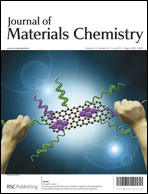Photocatalytic cellulosic electrospun fibers for the degradation of potent cyanobacteria toxin microcystin-LR†
Abstract
Non-woven, high surface area photocatalytic cellulosic electrospun fibers were fabricated for solar-light-driven water treatment purposes and tested for photocatalytic decomposition of the potent cyanobacteria toxin microcystin-LR (MC-LR). Electrospun fibers of cellulose acetate were converted to succinylated cellulose and then loaded with titania nanoparticles using a simple solution based technique. It was found that the type of titania nanoparticle (visible light activated or UV light activated), the surface area of the fiber mat, and loading solution pH all have an effect on the distribution of titania along the fibers. The titania coverage and surface area of the fiber mats were found to correlate well with the degree of MC-LR degradation under both visible and solar light irradiation. The difference in titania coverage, determined using X-ray photoelectron microscopy (XPS), was two to three times smaller in the lower surface area samples. These photocatalytic electrospun fibers could be advantageously used for drinking water and wastewater treatment applications using solar light as a renewable source of energy.


 Please wait while we load your content...
Please wait while we load your content...